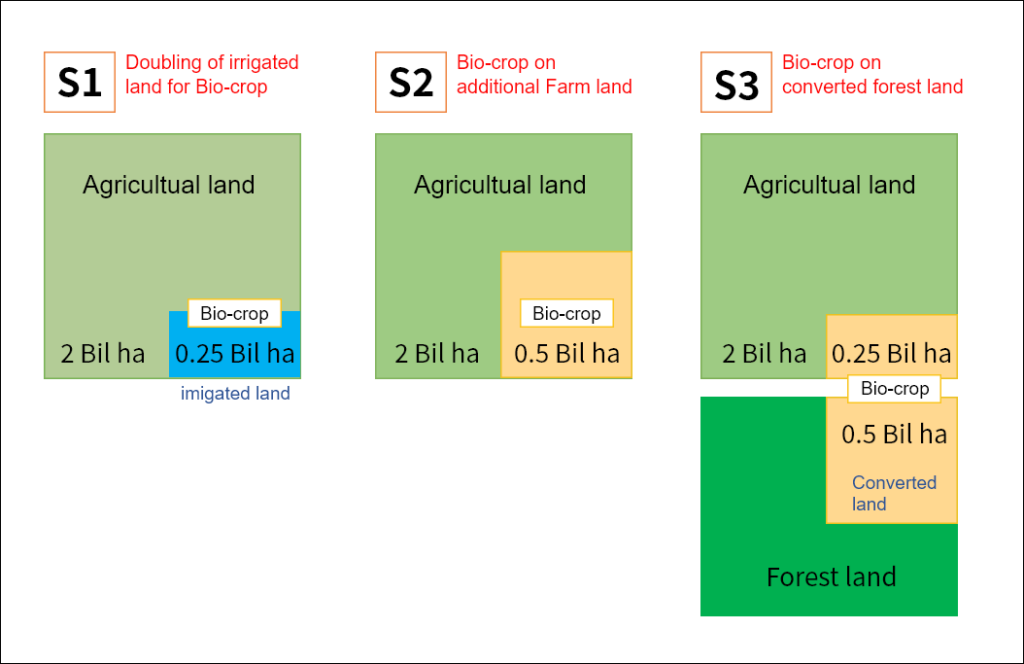INTERVIEW
There is a reason why seemingly vacant land is vacant.
Yoshiki YAMAGATA , Head, Global Carbon Project – Tsukuba International Office
c/o Center for Global Environmental Research,
National Institute for Environmental Studies (NIES)
Review editor for Chapter 6 of the IPCC Special Report on Climate Change and Land (SRCCL)
Interview date: 17 September 2019
Intervier venue: NIES
Interviewer: Mikiko KAINUMA, Senior Research Advisor,IGES
Kainuma: How was the concept of “negative emissions” evaluated?
Yamagata: If I were to briefly summarise: to realise the Paris Agreement, it is necessary to carry out activities with negative emissions that absorb and fix CO2 from the atmosphere in biomass through forestation and sequestration of carbon in the soil. Going forward, without putting policies in place for greenhouse gas-emitting sectors as quickly as possible — and, at the same time, improving agricultural productivity, making food production less carbon-intensive, and preventing land degradation — it is clear that negative emissions based on large-scale land use are not easy to achieve without effects on food security. In particular, implementing negative emissions technologies using large-scale Bio-Energy with Carbon Capture and Storage (BECCS) is predicted to have significant impacts on ecosystem services.
As an aside, I have been promoting collaborative international research on negative emissions as the head of the Global Carbon Project (GCP) — Tsukuba International Office.
http://www.cger.nies.go.jp/gcp/magnet.html
When this project started 7-8 years ago, hardly anyone knew what “negative emissions” were, but we thought that this would be an important research theme to meet the 2℃ target in the future. Thus, along with researchers from the International Institute for Applied Systems Analysis (IIASA), we developed a project known as the “Managing Global Negative Emissions Technologies”.
Kainuma: So, the idea of “negative emissions” originated during that period?
Yamagata: The discussion actually began 20 years ago, in an article in Science written from the perspective of climate change risk management.
https://science.sciencemag.org/content/294/5543/786b/tab-article-info
Even before then, we had been conducting research for a long time about climate action involving carbon sequestration via forests, and about the Kyoto Protocol. At this point, to realise the international agreement to reduce carbon long-term, we thought that it was necessary to provide scientific perspectives to the political discussion by thoroughly investigating how we carry out carbon sequestration at these large scales or, alternatively, whether we can actually do this in the first place. Eventually, BECCS, which was proposed in this paper, became a well-covered topic by the Intergovernmental Panel on Climate Change (IPCC) as well as at the Conference of the Parties (COP) to the United Nations Framework Convention on Climate Change (UNFCCC).
Kainuma: Regardless of the shared socio-economic scenario (SSP), a lot of land for biofuel production is necessary to keep the global average temperature rise to 1.5℃. Is it possible to secure this much land for biofuel production?
Yamagata: At the point when the IPCC Fifth Assessment Report (AR5) was released, leading researchers had shown through calculations that BECCS would require approximately one-fourth of the world’s farmland by 2100. Since then, other calculations showed that BECCS may need more than one-fourth of global farmlands. However, there is more acknowledgement of the “negative” aspect of negative emissions — that is, the large amount of land needed for BECCS — as well as the extent of its impact on sustainability. On the other hand, some researchers claim that BECCS is unnecessary if various climate actions are taken immediately. This report (SRCCL) shows that, while the scales at which they are implemented may differ, negative emission technologies, including BECCS, are indispensable to achieve the objectives of the Paris Agreement. Moreover, their feasibility is related to issues of agriculture and food, and the report sends a clear message that the feasibility must be properly evaluated based on the actual land use situation in each region.
This also became the basis of IPCC discussions, but a more quantitative assessment of negative emissions technology can be found in an article written by Pete Smith (coordinating lead author on Chapter 6 of the IPCC report for which I served as a review editor)(※1). In the article, there is an overview of the impacts of each negative emissions technology with respect to land, water, energy, costs, etc.
Kainuma: What about Direct Air Capture (DAC) technology?
Yamagata: I am not an expert on this, but DAC requires future technological development, funding and energy, and currently, it may not be easy to implement this technology. There are technological developments in absorbing CO2 from chimneys, but technologies that capture carbon from the atmosphere may be quite difficult to develop. Perhaps in a few decades that kind of technology may exist, but, to meet the Paris goals, it is necessary to realise “negative emissions” in the near future, and there is no time to wait for such new technologies to develop. To achieve the Paris goals without BECCS or other negative emissions technologies, it would be necessary to start substantially reducing global greenhouse gas emissions by around next year.
Kainuma: I think it is honestly difficult to start reducing greenhouse gases by next year. There are views that even the low energy demand scenario (the scenario that limits warming to 1.5℃ without using BECCS or fossil fuel energy production with CCS) in the Special Report on Global Warming of 1.5℃ (SR1.5) is quite difficult to achieve in reality.
Yamagata: Unfortunately, there are many such possibilities in reality, and, if we overshoot the 2℃ scenario for global greenhouse gas emissions leading up to 2030, further research is warranted. In order to realise the Paris Agreement, we need urgently to consider in which scenarios it is necessary to realise “negative emissions” and, alternatively, to recognise when this is no longer even an option.
I will digress a little from the IPCC Special Report to talk about our research and would like to introduce our team’s assessment on how much land will be needed in 2100 for biofuels. The following figures are three scenarios that illustrate the land use change necessary for BECCS. In the S1 scenario, the amount of land for biofuels is not increased, but biofuel cultivation is increased by irrigating the land. The S2 scenario describes converting agricultural land for biofuel crop cultivation, and the S3 scenario describes converting forest land to biofuel crop cultivation. However, we found that the current river flow is insufficient for scenario S1. In other words, there is a trade-off between the river drying up (S1), running out of food (S2), and running out of forests (S3). Regardless, it is clear that none of these options are sustainable.
Kainuma: If the river dries up or if we have no more forests, I believe there would be consequences for the climate, but do we not have to consider the impacts of climate change here?
Yamagata: When the above scenarios were created, we did not take climate change into account; however, if we consider climate change, I think that the results would be even more serious.
In that case, we would need to make land productivity more efficient or change our diets. Water, mechanisation, and fertiliser use are key to increasing agricultural productivity, but there are limits. To begin with, irrigating land that is not very fertile will not do much to increase productivity. As such, dietary changes become an option, but halting beef consumption is difficult. In reality, on the SRCCL, the BBC emphasised the necessity of changing diets to solve the global warming crisis, publishing the article along with a large photograph of a veggie burger.
Kainuma: How feasible is BECCS?
Yamagata: The feasibility of BECCS depends on the scale. Small-scale BECCS can realistically be implemented immediately across the globe. However, if we consider the large-scale BECCS that is currently estimated to be necessary to produce negative emissions of 3GtC, I think it is difficult to do this without sacrificing something: the sustainability of land, water, or the ecosystem. Moreover, regarding bioenergy plants, plants such as Chinese silver grass and willows are known. Whether there are impacts on ecosystems depends on the type of vegetation as well and we cannot make general conclusions. However, these practices may accelerate soil degradation, so it is necessary to devise measures such as fallowing.
Kainuma: Furthermore, when considering land rights, things are complicated, even in Japan. Given that rights to land are complicated in developing countries, it is difficult to drive things forward using the simple catchphrase of “climate action.”
Yamagata: Previously, someone told me, “There is no such thing as vacant land. There is a reason why vacant land (or land that looks that way) is vacant.” These words were very eye-opening to me. There is a reason why seemingly vacant land cannot be touched. The only exception to this are fallow fields, like in Japan, where wild vegetation grows. There is less we can do in reality than we imagine.
By the way, the idea of “using fallow fields” may be possible in Japan. It is said that one third of current rice paddies in Japan are fallow fields. Planting biofuel crops here is one idea. Energy sharing by installing solar panels on fallow fields has already been progressing thanks to feed-in tariffs, but there is a possibility of extending this to biofuels.
Kainuma: 92% of Japan’s energy is dependent on imports, and for food self-sufficiency, 63% of calories in Japan are sourced abroad. Those facts may help to change this status quo.
Yamagata: Exactly. In Brazil, they are using gasoline mixed with ethanol, and it would be good if the same could be done in Japan. Don’t you think it’s a good idea to fuel light trucks running through the countryside with local fuel? I think that using fallow fields may even lead to the revitalisation of rural areas in Japan. I think it is high time to fully consider local-based research such as assessments of local food and sustainable use of biomass in Japan. The Satoyama Initiative and the Circulating and Ecological Economy concept are relevant, so I hope that NIES and IGES can move forward with collaborative research in the future.
Kainuma: Thank you very much for your time today. We would like to wrap up soon, but to finish off, please tell us anything that you want to ultimately emphasise.
Yamagata: Thank you. Firstly, if average temperatures increase by approximately 2℃, then the rise in temperature and CO2 concentrations may increase crop productivity in some cases. However, some point out that, if there is a 3℃-rise, then the CO2 is released from the soil more quickly and natural ecosystems are no longer carbon sinks. This will result in positive feedback, heightening the risk of accelerating global warming. In reality, observing the recent serious forest fires in Siberia and Brazil, such consequences may come sooner. We can say that we do not have a lot of time left to act to tackle global warming.
I think that the key message here is to think of all the measures and interventions that keep us on track with the RCP1.9 emission pathway(※3) and make possible a sustainability-focused society that adopts social and technological innovations (SSP1 scenario). Then, we must do everything that we can.
Although the impact of global warming is already evident and urgent action is needed, negative emissions initiatives like BECCS cannot be implemented immediately. Furthermore, considering land use restrictions, such initiatives cannot be undertaken at large scales. Not implementing BECCS would be ideal, but realistically, there is an increasing risk of overshooting our emissions. As such, the question remains: how can we introduce BECCS sustainably? As stated earlier, “there is a reason why vacant land is vacant.” If BECCS were to be introduced, rather than setting unrealistic expectations for developing countries, I think that developed countries should provide the model.
Actually, I would like to point out to Japanese companies as well that, as negative emission technologies are thought to become increasingly important in the future, people in Europe are acknowledging that “negative emissions” may become its own sector. In fact, Sweden, along with representatives from the negative emissions sector, hosted the first International Conference on Negative CO2 Emissions last year.
Moreover, in particular, the Japanese idea of using fallow fields can lead to greater self-sufficiency of energy and food. On top of this, such activities have the potential to lead to the revitalisation of rural areas. But first, I think it is important that Japan shows that it will do what it can on its own.
Kainuma: Great. Thank you for today.
※1 Pete Smith et al. (2015): Biophysical and economic limits to negative CO2 emissions
※2 Yoshiki Yamagata et al. (2018): Estimating water-food-ecosystem trade-offs for the global negative emission scenario (IPCC-RCP2.6)
※3 Pathway in alignment with a 1.5-℃ increase in temperature.
 Leveraging a Climate-neutral Society
Leveraging a Climate-neutral Society


